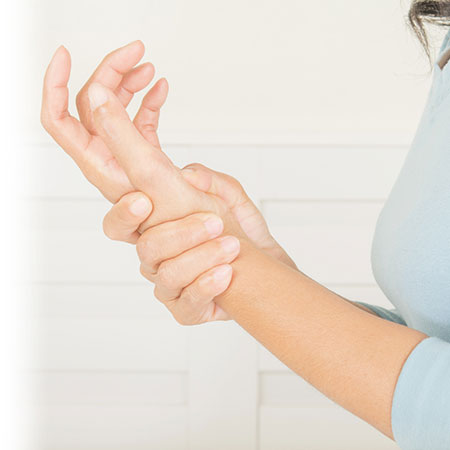Arthritis pain can be detrimental to your well being. However, an adequate treatment plan coupled with healthy habits can make a difference.
What is arthritis?
Arthritis is a general term that refers to several chronic illnesses affecting the joints. About one in five people are affected by this type of condition. Osteoarthritis and rheumatoid arthritis are the most common forms of this disease. Osteoarthritis is more prevalent than rheumatoid arthritis. In fact, 1 in 10 Canadians have osteoarthritis, while 1 in 100 have rheumatoid arthritis.
Pain is one of the typical symptoms of arthritis. It can come and go, but in most cases, the muted pain persists. Coping with pain may require a number of strategies, such as combining medication with alternative treatments, to obtain optimal relief.
This article focuses on pain relief for osteoarthritis.
What are the symptoms of osteoarthritis?
When someone has osteoarthritis, the cartilage in the joints gradually breaks down, making movement more difficult and painful. Osteoarthritis can affect several joints, including the hands, spine, knees, and hips.
Typical signs and symptoms of osteoarthritis include the following:
- joint stiffness felt within 30 minutes of getting up (in the morning)
- joint discomfort or pain, especially during and after use, and during weather changes
- loss of strength and flexibility in the joint
- joint crepitus (cracking)
- swelling and deformity of the joint
What are the possible treatments?
In some cases, osteoarthritis symptoms cause enough discomfort to warrant the use of reliever medications. Many of these drugs are available over the counter. Here are some examples.
Acetaminophen
This well-known medication is widely used. Acetaminophen is used to relieve pain from a variety of sources. Due to its favourable side effect profile, it is considered the first-line treatment for osteoarthritis pain. In fact, acetaminophen is very safe when taken in the correct dosage. However, when taken in high doses, it can pose a health risk.
If you are taking acetaminophen, speak to your doctor and pharmacist to ensure optimal and safe use of it.
Anti-inflammatory drugs
This class of medications provides effective relief of pain and inflammation. Some over-the-counter formulations are taken by mouth, while others are intended for topical (local) application. A consultation with a pharmacist is sometimes necessary to obtain them. Doctors sometimes prescribe anti-inflammatory drugs requiring a prescription to ease osteoarthritis pain.
These types of drugs sometimes carry a risk of adverse effects, and there are some contraindications and warnings to be aware of. Additionally, anti-inflammatory drugs can interact with other medications. This is why it is important to always speak with a healthcare professional (doctor or pharmacist) before taking them.
Other treatments
Other options may be considered in some cases, such as the prescription of various medications, the injection of a liquid similar to synovial fluid (the fluid that protects the joints), and complementary treatment methods. In the most severe cases, surgery may be considered.
Glucosamine and chondroitin are natural products that are believed to be effective in reducing osteoarthritis pain. However, they must be taken for several weeks before the benefits are felt. Always seek the advice of a pharmacist before taking any natural health product.
Beyond medication, what can be done to reduce pain?
When you live with arthritis, certain measures or lifestyle changes can help prevent or reduce pain. Here are a few tips to help you do just that:
- rest the painful joint if you feel fatigue, discomfort or pain. Caution, immobility sometimes makes symptoms worse.
- Exercise regularly. A physiotherapist may recommend exercises to strengthen your muscles and increase your range of motion.
- Maintain a healthy weight. Excess weight puts a strain on joints, including the spine, knees, and hips.
- When pain is acute, apply heat or cold to ease pain and stiffness. Sometimes, heat is preferable, other times cold. Discuss this with a healthcare professional.
Speak to your pharmacist for additional information about arthritic pain relief.

